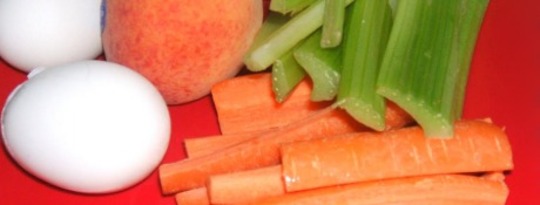
Most snack foods contain sugar, refined carbohydrates, and often trans fats as well. This can make healthy snacking difficult. However, there are a variety of insulin-friendly snacks that you can either prepare in advance or quickly when you want them.
Protein is more difficult to obtain in a snack than anything else, and it is not always possible to choose a high BV protein at such times. (BV - Biological Value - is the qualitative measure of a protein.) The snack suggestions below all contain some form of protein and, in many cases, some essential fats too.
Calcium can help you lose weight. This is why I’ve included calcium-rich foods in the snacks below.
Remember to chew your snacks as thoroughly as your main meals.
The snacks contain a variety of foods with different “mouth-feels” to them, which is an important component of a satisfying snack.
Dips: Deceptively High in Calories
Dips bought from the supermarket or deli are a great favorite with many people — but have you checked out the ingredients in some of them? Avoid those with a lot of additives and go for those that are as “natural” as possible, with the fewest ingredients.
Be aware, however, that dips are a deceptively rich source of calories. Taramasalata, full-fat hummus, cream-cheese dips, guacamole, and so on, are very high in fat calories and, while they do not upset insulin levels in the way refined carbs do, you should beware of consuming too much if you need to lose weight.
On this basis, small is definitely beautiful. Small quantities of dips, such as low-fat hummus, are fine for mid-morning or mid-afternoon snacks with carrot sticks or rye crackers. They can also be eaten at mealtimes — add them to salads instead of a dressing, or use a small amount to increase the variety and taste of a meal.
 15 Snacks That Taste Good & Are Good For You!
15 Snacks That Taste Good & Are Good For You!
- Tahini (sesame seed spread), liberally spread on rye crackers or 2 rice cakes, with a sugar-free yogurt.
- Crudites (strips of raw carrot, bell pepper, cucumber, celery) and hummus, with 8 almonds
- A small pear, 15 almonds or cashews and a sugar-free yogurt
- A few slim crackers (e.g. rye crackers or thin rice cakes) spread with tahini and topped with some sliced apple
- A handful of walnut pieces mixed with a small cubed apple, a tablespoon of blueberries and sugar-free yogurt
- One tablespoon of organic peanut butter blended into a natural yogurt. Add to chilled diced apple or pear for a delicious and refreshing snack
- Two tablespoons of low-fat cottage cheese with carrot or celery sticks and a tablespoon of sunflower seeds
- Goat’s cheese on a cracker (rye crackers or rice cakes) with 8 sliced red grapes
- Half a cup of strawberries blended with 2 to 3oz of silken tofu and served chilled
- Lettuce-wrapped chicken breast slices x 2, with finely diced crunchy vegetables. (Your food processor has a function for turning whole vegetables into this size in seconds — now is the time to use it!)
- Half a cup of raspberries with cottage cheese and a teaspoon of sesame seeds
- Three bean salad, with a tablespoon of sunflower seeds
- Hard-boiled egg salad with carrot sticks (2 eggs or 1 egg and 2 egg whites)
- Tuna (1oz) and salad with a plain yogurt and lemon dressing topped with 8 cashews or walnuts
- Cottage cheese with strawberries and pumpkin seeds
Desserts, Like the Typical Modern Breakfast, are Sugarfests
As you have probably guessed, the majority of desserts are a diversion off your path to reversing Insulin Resistance*. In a strange way they are like the typical modern breakfast — they are usually sugarfests and will upset your blood glucose and insulin levels.
You should aim to give up desserts, other than a yogurt or piece of fruit for example, until you have reversed your Insulin Resistance. When you have reversed your Insulin Resistance you can indulge occasionally but remember to stick to the 90 percent rule — only have desserts 10 percent of the time!
* Insulin Resistance is a condition that occurs when, for a variety of reasons, your body makes too much insulin. This has many important implications for your metabolism and your general health -- in essence, it makes you overweith and tired, and it dramatically increases your risk, first of heart disease and then of type II diabetes. Insulin Resistance is also known as Syndrome X and the Metabolic Syndrome. There are different degrees of Insulin Resistance
©2004, 2012 by Antony Haynes. All rights reserved.
Reprinted with permission of the publisher, Conari Press,
an imprint of Red Wheel/Weiser, LLC. www.redwheelweiser.com.
This article was adapted with permission from the book:
The Insulin Resistance Factor: A Nutritionist's Plan for Reversing the Effects of Syndrome X -- by Antony J. Haynes.
 Insulin resistance, commonly known as Syndrome X, affects a staggering 1 in 5 people. It is characterized by the over-production of insulin and is the underlying cause of many serious health problems including heart disease, type II diabetes, obesity, high blood pressure, and deep vein thrombosis. The Insulin Resistance Factor offers a unique nutritional plan to reverse the effects of insulin resistance through diet, exercise, and nutritional supplements.
Insulin resistance, commonly known as Syndrome X, affects a staggering 1 in 5 people. It is characterized by the over-production of insulin and is the underlying cause of many serious health problems including heart disease, type II diabetes, obesity, high blood pressure, and deep vein thrombosis. The Insulin Resistance Factor offers a unique nutritional plan to reverse the effects of insulin resistance through diet, exercise, and nutritional supplements.
Click here for more info or to order this book.
About the Author
 Antony J. Haynes is one of the most experienced and knowledgeable nutritionists in Great Britain. He is the director of the highly acclaimed Nutrition Clinic in Harley Street, London, and has taught Advanced Nutrition courses and workshops for the last ten years. He is the author of The Food Intolerance Bible. Learn more about him and Insulin Resistance at www.insulinfactor.co.uk
Antony J. Haynes is one of the most experienced and knowledgeable nutritionists in Great Britain. He is the director of the highly acclaimed Nutrition Clinic in Harley Street, London, and has taught Advanced Nutrition courses and workshops for the last ten years. He is the author of The Food Intolerance Bible. Learn more about him and Insulin Resistance at www.insulinfactor.co.uk
























